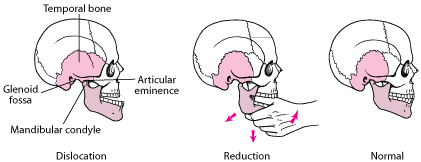Today we're talking TMJ dislocations. Ever seen one of these? They're kind of cool to reduce. We'll be discussing several ways to reduce these, starting with the classic way, and followed by 2 creative approaches. How do these occur? After extreme opening of the mouth - ex: yawning, dental work, biting into a very large sandwich (not kidding).
Diagnosis is clinical! These are typically anterior dislocations, meaning the mandibular condyle is displaced anteriorly from its articular groove in the temporal bone. Pictures below.
 Now let's talk reduction!
Now let's talk reduction!
First, the classic intra-oral approach: this involves the physician placing his/her thumbs into the patient's mouth along the lower molars, and applying posterior and inferior force to guide the mandible back into its groove, like so:
 Downsides:
- Often requires procedural sedation
- Requires a surprisingly large amount of force
- You have to put your hands into the patient's mouth, which is risky
Downsides:
- Often requires procedural sedation
- Requires a surprisingly large amount of force
- You have to put your hands into the patient's mouth, which is risky
Luckily, there is not one, but two better ways! The extra-oral reduction technique, and the hands-free "syringe technique." Intrigued?
Extra-oral technique: When the mandible is dislocated, the coronoid process is palpable externally over the cheek. By applying steady posterior pressure over the coronoid, the mandible can be easily reduced. You'll know it's in when the coronoid process is no longer palpable.
 Use your other hand to provide support and gentle counter-traction (figure 4).
Use your other hand to provide support and gentle counter-traction (figure 4).
 This video shows it's really as easy as it sounds: https://youtu.be/N3edJvp5DoA
This video shows it's really as easy as it sounds: https://youtu.be/N3edJvp5DoA
And if that doesn't work, try the hands-free syringe method (diagram below):
- Place a 5 or 10 mL syringe between the patient's molars on the dislocated side. - Instruct the patient to bite down and roll the syringe back and forth between the teeth until reduction is achieved. - This method utilizes the patient's own jaw musculature to create the posterior/inferior forces for jaw relocation.

A nice 2 min video overview where the syringe technique is demonstrated: https://coreem.net/procedures/tmj-reduction/
That's all for today. Happy New Year's, everyone!
References: https://www.aliem.com/2016/01/trick-of-the-trade-extra-oral-technique-for-reduction-of-anterior-mandible-dislocation/ https://coreem.net/journal-reviews/syringe-technique/






